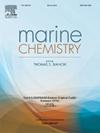Influence of the Mackenzie River plume dispersal on the dissolved barium concentrations in the upper Canada Basin waters
IF 2.5
3区 地球科学
Q2 CHEMISTRY, MULTIDISCIPLINARY
引用次数: 0
Abstract
Dissolved barium has been shown to have the potential to track river runoff in marine waters. In this study, the distribution of dissolved barium was determined in the upper 450 m waters of the Canada Basin along the Joint Ocean Ice Study 140°W transect in August/September 2019–2021. In these highly stratified Canada Basin waters, the dBa concentrations increased from 42.51 nmol kg−1 in the Atlantic waters to 128.91 nmol kg−1 in the polar mixed layer. The dispersal of Ba-rich surface waters found over the slope and outer shelves is attributed to the Mackenzie River plume. These waters were either confined nearshore with northwest winds (2019 and 2020) or entrained into the Beaufort Gyre interior under easterly winds (2021). In the subsurface layers, the vertical variation in barium concentration in the Pacific Winter Water and Atlantic Halocline waters showed evidence of mixing. Dissolved Ba dynamics provide a window into the complex interplay between physical, biological, and chemical processes in Arctic waters, making it a valuable tracer for understanding ocean circulation, nutrient transport, and ecosystem functioning in the rapidly changing Arctic region.
麦肯齐河羽流扩散对加拿大盆地上游水域溶解钡浓度的影响
溶解的钡已被证明具有追踪海水中河流径流的潜力。本研究于2019年8 / 9月- 2021年9月在加拿大盆地140°W样带上450 m水域测定了溶解钡的分布。在这些高度分层的加拿大盆地水域,dBa浓度从大西洋水域的42.51 nmol kg−1增加到极地混合层的128.91 nmol kg−1。在斜坡和外大陆架上发现的富含ba的地表水的扩散归因于麦肯齐河的羽流。这些水域要么被西北风(2019年和2020年)限制在近岸,要么被东风(2021年)带入波弗特环流内部。在次表层,太平洋冬季水和大西洋盐斜海水钡浓度的垂直变化表现出混合的迹象。溶解Ba动力学为了解北极水域物理、生物和化学过程之间复杂的相互作用提供了一个窗口,使其成为了解快速变化的北极地区海洋环流、营养物质运输和生态系统功能的有价值的示踪剂。
本文章由计算机程序翻译,如有差异,请以英文原文为准。
求助全文
约1分钟内获得全文
求助全文
来源期刊

Marine Chemistry
化学-海洋学
CiteScore
6.00
自引率
3.30%
发文量
70
审稿时长
4.5 months
期刊介绍:
Marine Chemistry is an international medium for the publication of original studies and occasional reviews in the field of chemistry in the marine environment, with emphasis on the dynamic approach. The journal endeavours to cover all aspects, from chemical processes to theoretical and experimental work, and, by providing a central channel of communication, to speed the flow of information in this relatively new and rapidly expanding discipline.
 求助内容:
求助内容: 应助结果提醒方式:
应助结果提醒方式:


